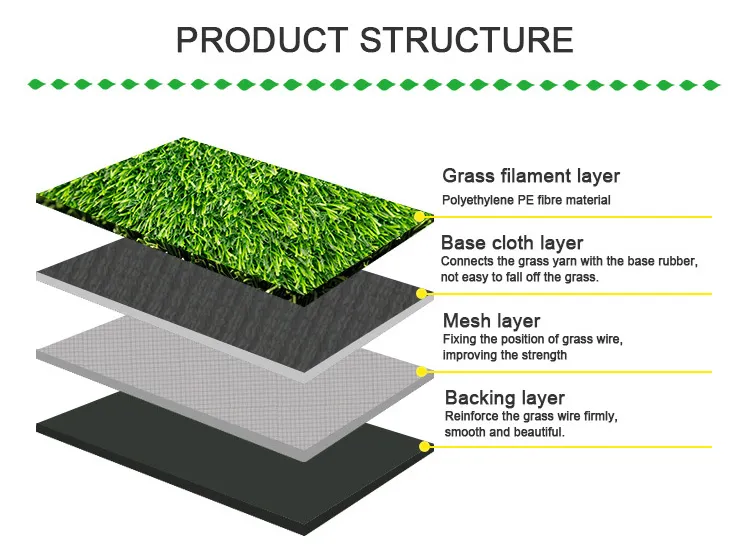
- Afrikaans
- Arabic
- Belarusian
- Bengali
- Czech
- Danish
- Dutch
- English
- Esperanto
- Estonian
- Finnish
- French
- German
- Greek
- Hindi
- Hungarian
- Icelandic
- Indonesian
- irish
- Italian
- Japanese
- kazakh
- Rwandese
- Korean
- Kyrgyz
- Lao
- Latin
- Latvian
- Malay
- Mongolian
- Myanmar
- Norwegian
- Persian
- Polish
- Portuguese
- Romanian
- Russian
- Serbian
- Spanish
- Swedish
- Tagalog
- Tajik
- Thai
- Turkish
- Turkmen
- Ukrainian
- Urdu
- Uighur
- Uzbek
- Vietnamese
Exploring Benefits and Features of Eco-Friendly Football Turf Solutions
Dec . 25, 2024 12:40 Back to list
Green Football Turf Revolutionizing the Game
In recent years, the world of sports has witnessed significant advancements in technology and materials, particularly in artificial playing surfaces. One of the most notable innovations has been the development of green football turf, a synthetic alternative that has transformed how athletes train and compete. This innovation not only enhances performance but also contributes positively to the environment.
The Evolution of Football Turf
Traditionally, football fields were made of natural grass, which required extensive maintenance, including watering, mowing, and fertilizing. However, the high demand for modern sports facilities, combined with the challenges of climate and usage, paved the way for artificial turf. The first generation of synthetic grass emerged in the 1960s, but it was not until the mid-2000s that significant improvements were made, leading to the introduction of realistic, durable, and environmentally-friendly options like green football turf.
Modern green football turf is designed to mimic the aesthetic and feel of natural grass while providing a consistent playing surface. This technological innovation has garnered attention from professional leagues to community programs, changing the face of football everywhere.
Benefits of Green Football Turf
1. Durability and Low Maintenance One of the main advantages of green football turf is its durability. Unlike natural grass, which can suffer from damage due to heavy foot traffic, adverse weather conditions, or improper care, synthetic turf can withstand rigorous play without losing its quality. This resilience means that teams can train and play more frequently, which is essential for player development.
2. Environmental Impact Green football turf is not only a practical choice but also a sustainable one. While the production of synthetic turf does have an environmental footprint, the long-term benefits outweigh the initial impact. For example, synthetic turf does not require water, pesticides, or fertilizers, reducing the ecological burden associated with maintaining natural grass. Additionally, many turf products are now made from recycled materials, further minimizing environmental harm.
green football turf

3. Injury Reduction Safety is a paramount concern in sports, and the development of advanced synthetic turfs has contributed to injury reduction. Modern green football turf is designed with shock-absorbing properties that help mitigate the impact on players' joints. This is particularly important for football, a sport known for its physicality. By providing a safer playing surface, teams can help protect their athletes from common injuries, such as sprains and concussions.
4. Versatility of Use Green football turf is not just limited to professional stadiums; its versatility opens up opportunities for schools, parks, and recreational centers. Communities can develop multi-use fields that cater to various sports, including soccer, rugby, and even track and field events. This adaptability maximizes resources and provides more opportunities for youth engagement in sports.
Challenges and Considerations
Despite the numerous benefits, the transition to green football turf is not without challenges. Concerns regarding the heat retention of synthetic surfaces in hot climates, potential health risks associated with certain infill materials, and issues around waste disposal at the end of the turf's life span must be addressed. Ongoing research and development are focused on finding solutions to these challenges to make green football turf even more sustainable and safe for athletes.
The Future of Football Turf
The future looks promising for green football turf and its role in the world of sports. Innovations will likely continue to improve the texture, performance, and sustainability of synthetic surfaces, making them an even more attractive option for teams and facilities. As awareness grows around the environmental impacts of traditional maintenance methods, the demand for green football turf will likely increase, supporting the movement towards greener practices in sports.
In conclusion, green football turf stands at the intersection of technology, sustainability, and athletic performance. It represents a significant leap forward in how we approach sports facilities, ultimately enriching the playing experience for athletes while contributing positively to our environment. As we embrace these advancements, we pave the way for a future where sports can thrive in harmony with ecological responsibility.
-
The Benefits of Artificial Turf for Indoors
NewsJul.15,2025
-
How Artificial Grass Suppliers Ensure Quality Products
NewsJul.15,2025
-
Artificial Grass and Pets: A Space for Relaxation
NewsJul.08,2025
-
Balcony & Outdoor Decoration with Artificial Grass
NewsJul.08,2025
-
Best Indoor Artificial Grass for Home
NewsJul.07,2025
-
Best Pet Turf for Dogs: Safe & Durable Artificial Grass Options
NewsJul.07,2025
Products categories









